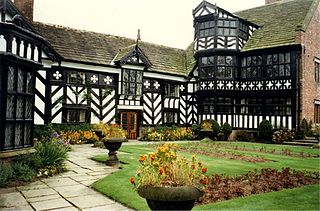
Gawsworth Old Hall is a Grade I listed country house in the village of Gawsworth, Cheshire, England. It is a timber-framed house in the Cheshire black-and-white style. The present house was built between 1480 and 1600, replacing an earlier Norman house. It was probably built as a courtyard house enclosing a quadrangle, but much of it has been demolished, leaving the house with a U-shaped plan.

Kingston Lacy is a country house and estate near Wimborne Minster, Dorset, England. It was for many years the family seat of the Bankes family who lived nearby at Corfe Castle until its destruction in the English Civil War after its incumbent owners, Sir John Bankes and Dame Mary, had remained loyal to Charles I.

The Wallace Collection is a museum in London occupying Hertford House in Manchester Square, the former townhouse of the Seymour family, Marquesses of Hertford. It is named after Sir Richard Wallace, who built the extensive collection, along with the Marquesses of Hertford, in the 18th and 19th centuries. The collection features fine and decorative arts from the 15th to the 19th centuries with important holdings of French 18th-century paintings, furniture, arms and armour, porcelain and Old Master paintings arranged into 25 galleries. It is open to the public and entry is free.

Russborough House is a stately house near the Blessington Lakes in County Wicklow, Republic of Ireland. Located between the towns of Blessington and Ballymore Eustace, it is an outstanding example of Palladian architecture, designed by Richard Cassels for Joseph Leeson, 1st Earl of Milltown and built between 1741 and 1755. With a frontage measuring 210 m (690 ft), it may be the longest house in Ireland. The interior contains fine ornate plasterwork on the ceilings by the Lafranchini brothers, who also collaborated with Castle on Carton House. Russborough contains an important private collection of European fine and decorative arts, including furniture, silver, porcelain and paintings.
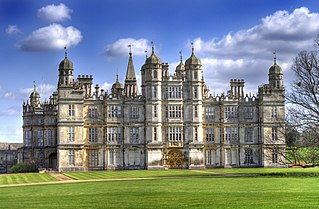
Burghley House is a grand sixteenth-century English country house near Stamford, Lincolnshire. It is a leading example of the Elizabethan prodigy house, built and still lived in by the senior (Exeter) branch of the Cecil family and is Grade I listed.

Kenwood House is a stately home in Hampstead, London, on the northern boundary of Hampstead Heath. The present house, built in the late 17th century, was remodelled in the 18th century for William Murray, 1st Earl of Mansfield by Scottish architect Robert Adam, serving as a residence for the Earls of Mansfield until the 20th century.

Lydiard Park is a 260-acre (110-hectare) country park at Lydiard Tregoze, which was its former name, about 3 miles (5 km) west of central Swindon, Wiltshire, England, in West Swindon parish, near Junction 16 of the M4 motorway.

Little Moreton Hall, also known as Old Moreton Hall, is a moated half-timbered manor house 4.5 miles (7.2 km) south-west of Congleton in Cheshire, England. The earliest parts of the house were built for the prosperous Cheshire landowner William Moreton in about 1504–08 and the remainder was constructed in stages by successive generations of the family until about 1610. The building is highly irregular, with three asymmetrical ranges forming a small, rectangular cobbled courtyard. A National Trust guidebook describes Little Moreton Hall as being "lifted straight from a fairy story, a gingerbread house." The house's top-heavy appearance, "like a stranded Noah's Ark", is due to the Long Gallery that runs the length of the south range's upper floor.
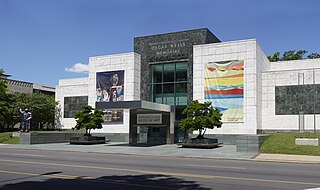
The Birmingham Museum of Art is a museum in Birmingham, Alabama. Its collection includes more than 24,000 paintings, sculptures, prints, drawings, and decorative arts representing various cultures, including Asian, European, American, African, Pre-Columbian, and Native American. The museum is also home to some Renaissance and Baroque paintings, sculptures,and decorative arts from the late 13th century to c. 1750.
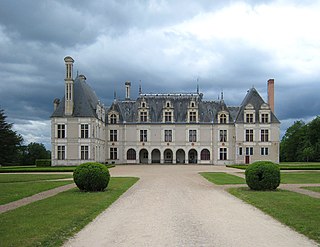
The Château de Beauregard is a Renaissance château in the Loire Valley in France. It is located on the territory of the commune of Cellettes, a little south of the city of Blois and a few miles from other famous Loire châteaux such as Cheverny. Although still inhabited, it can be visited by tourists. The château is renowned for its gallery of portraits decorated in the 17th century with 327 portraits of famous people.

Cusworth Hall is an 18th-century Grade I listed country house in Cusworth, near Doncaster, South Yorkshire in the north of England. Set in the landscaped parklands of Cusworth Park, Cusworth Hall is a good example of a Georgian country house. It is now a country house museum.

Rothe House is a late 16th-century merchant's townhouse complex located in the city of Kilkenny, Ireland. The complex was built by John Rothe Fitz-Piers between 1594 and 1610 and is made up of three houses, three enclosed courtyards, and a large reconstructed garden with orchard. As a museum, it is accessible to the public.

Lytes Cary is a manor house with associated chapel and gardens near Charlton Mackrell and Somerton in Somerset, England. The property, owned by the National Trust, has parts dating to the 14th century, with other sections dating to the 15th, 16th, 18th, and 20th centuries. "Yet all parts blend to perfection with one another and with the gentle sunny landscape that surrounds them," comments Nikolaus Pevsner. The House is listed as Grade I by English Heritage.
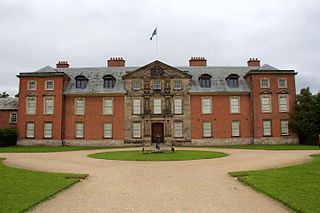
Dunham Massey Hall, usually known simply as Dunham Massey, is an English country house in the parish of Dunham Massey in the district of Trafford, near Altrincham, Greater Manchester. During World War I it was temporarily used as the Stamford Military Hospital.

Art Museum Riga Bourse is a museum in Riga, Latvia. It was established in 1920 and contains the most extensive collection of world art in Latvia from Ancient Egyptian/Middle Eastern art dating back to 5000 BC to present.

The Liria Palace is a neoclassical palace in Madrid, Spain. It is the Madrid residence of the Dukes of Alba.

The Palace of the Kraków Bishops in Kielce, was built in the 17th century as a summer residence of bishops of Kraków in Kielce, Poland. The architecture of the palace constitutes a unique mélange of Polish and Italian traditions and reflects political ambitions of its founder. Currently the palace houses a branch of the National Museum with an important gallery of Polish paintings.

Fairfield House is a historic house in Stogursey, Somerset, England. A house existed on the site from the 12th century and it has been owned by the same family since that time. The current building is largely 16th-century, but has undergone various remodellings since then. It is designated as a Grade II* listed building.

Romney's House at 5 Holly Bush Hill, Hampstead, Camden, London was the home of the artist George Romney and then of the architect Clough Williams-Ellis. It is a Grade I listed building.

Gainsborough's House is the birthplace of the leading English painter Thomas Gainsborough. It is now a museum and gallery, located at 46 Gainsborough Street in Sudbury, Suffolk, England. It is a Grade I listed building. Some of the pictures on display have been acquired with the help of the Art Fund.

























